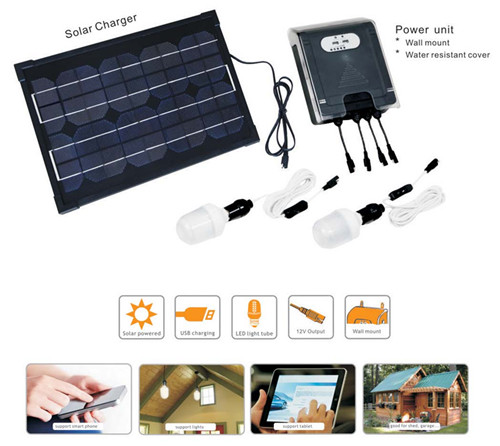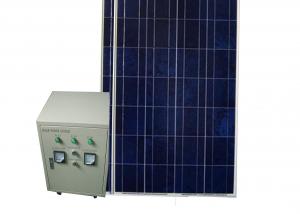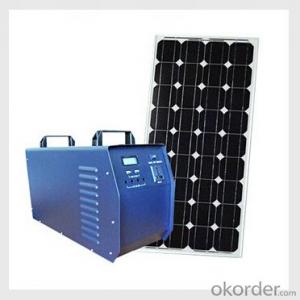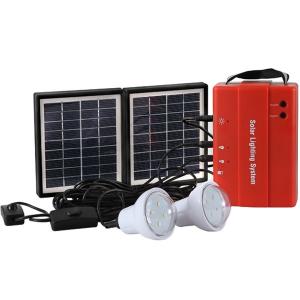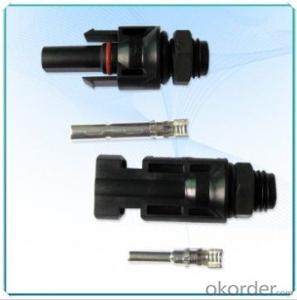TPS-205N 10W Solar wall mount
- Loading Port:
- China Main Port
- Payment Terms:
- TT or LC
- Min Order Qty:
- -
- Supply Capability:
- 50000sets m.t./month
OKorder Service Pledge
Quality Product, Order Online Tracking, Timely Delivery
OKorder Financial Service
Credit Rating, Credit Services, Credit Purchasing
You Might Also Like
TPS-205N 10W Solar Wall Mount Kit
1. 10W Mono Solar panel +12V/7AH Power pack(water resistant cover) + 2pcs 3W LED Lighting with switch +
2pcs USB Charging output (one for iphone and another one for your lamptop)+ 1pcs 12V charging output
2. Working time:more than5 hours for 2pcs LED light, useful for two rooms
3.Mobile phone adapotors and switch wire availbale for power small DC application
Packing Information:
1)1pc*10W Mono solar panel and 1pc*Power pack(metal box)
2)2 pcs 3W LED lights, Switch wire
Outer carton size: 370*165*485mm
Gross weight: 4.9kgs
574 PCS per 20' container
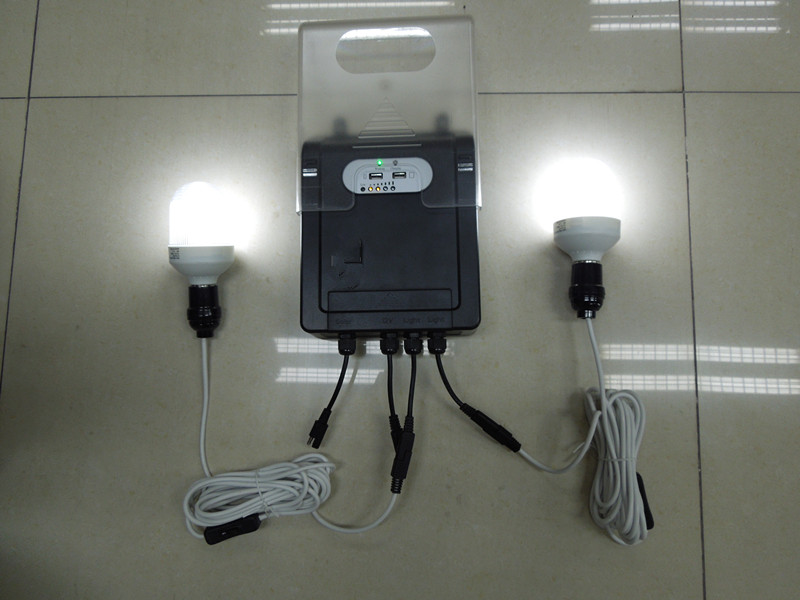
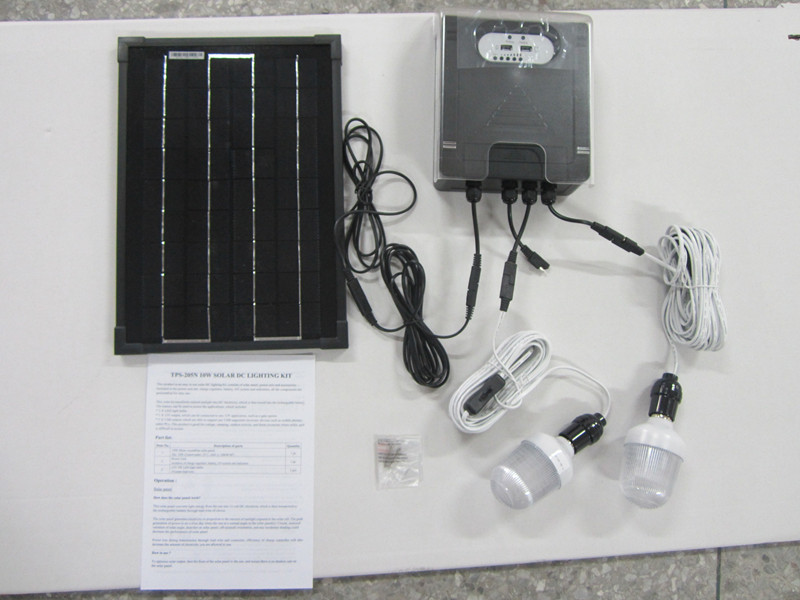
- Q: Can a solar energy system be installed in an area with a high bird population?
- Indeed, it is possible to install a solar energy system in an area abundant with birds. However, it is necessary to take certain precautions in order to minimize any potential risks or problems. Birds may be attracted to the solar panels and may perch on them or build nests. As a result, there is a possibility of bird droppings and debris accumulating on the panels, which can diminish their efficiency. To address these risks, there are several measures that can be taken. One option is to incorporate bird deterrents, such as spikes or netting, around the solar panels to dissuade birds from landing or nesting on them. It is important, though, to design these deterrents in a manner that does not block the sunlight required for the panels to produce electricity. Regular maintenance and cleaning of the solar panels can also contribute to their optimal performance. This entails removing any bird droppings, nests, or other debris that may accumulate over time. By keeping the panels clean, their efficiency can be maintained, and potential damage can be minimized. Furthermore, the selection of a suitable location for the solar energy system installation is essential. Placing the panels away from trees or structures that may entice birds to nest can help reduce the likelihood of bird-related issues. In summary, with proper planning, installation, and maintenance, it is feasible to successfully implement a solar energy system in an area teeming with birds while minimizing any potential negative impacts on its functionality.
- Q: Are there any tax credits available for installing a solar energy system?
- Yes, there are tax credits available for installing a solar energy system. The federal government offers a Solar Investment Tax Credit (ITC) that allows homeowners and businesses to deduct a percentage of the system's cost from their taxes. Additionally, some states and local governments may also offer their own tax incentives for solar installations.
- Q: Can solar energy systems be used for powering boats?
- Yes, solar energy systems can be used to power boats. Solar panels can be installed on the boat to capture sunlight and convert it into electrical energy, which can then be used to power various systems onboard, including propulsion, lighting, and navigation equipment. This renewable energy source is increasingly being adopted by boat owners as it reduces dependence on fossil fuels, lowers operating costs, and helps to minimize environmental impact.
- Q: Can solar energy systems be integrated with battery storage?
- Yes, solar energy systems can be integrated with battery storage. Battery storage allows excess energy generated from solar panels to be stored and used during times when the sun is not shining, such as at night or during cloudy days. This integration helps provide a continuous and reliable source of electricity, reducing reliance on the grid and maximizing the benefits of solar energy.
- Q: How does the tilt of solar panels affect their performance?
- The performance and overall efficiency of solar panels are significantly influenced by their tilt. Various factors, such as geographical location, season, and application, determine the optimal tilt angle. The primary purpose of the tilt angle is to maximize sunlight capture by the solar panels. Sunlight is converted into electricity by these panels, and the angle at which they are tilted impacts the amount of sunlight they receive. In general, solar panels generate the most electricity when they are perpendicular to the sun's rays. This means that during peak sunlight hours, panels tilted at an optimal angle will receive the maximum solar radiation. If the angle is too steep or shallow, the panels' ability to capture sunlight decreases, resulting in reduced performance. The optimal tilt angle also varies with the season. In summer, when the sun is higher in the sky, a steeper tilt angle may be more suitable for capturing maximum sunlight. Conversely, during winter, a shallower tilt angle can ensure that the panels receive sunlight even at lower sun angles. Geographical location is another crucial factor that affects the tilt angle of solar panels. The closer a location is to the equator, the less variation there is in the sun's angle throughout the year. Consequently, the optimal tilt angle for solar panels may be closer to the latitude of the location. For instance, equatorial regions often mount solar panels nearly flat to maximize exposure to the sun's rays. Apart from maximizing sunlight exposure, the tilt angle also impacts the self-cleaning capability of solar panels. Rainfall can wash away dirt and debris from the panel's surface, preventing grime buildup that reduces efficiency. A proper tilt angle facilitates the natural cleaning process by allowing rainwater to flow down the surface more effectively. To summarize, the tilt angle directly affects the performance of solar panels. By determining the optimal tilt angle based on geographical location, season, and desired performance, solar panels can capture the maximum sunlight, leading to higher electricity generation and overall efficiency.
- Q: What is net metering?
- Net metering is a billing arrangement that allows solar panel owners to receive credit for the excess electricity they generate and feed back into the grid. This means that when their solar panels produce more electricity than they need, the surplus is sent to the grid, effectively spinning their energy meter backwards and reducing their future electricity bills.
- Q: Do solar energy systems work during cloudy days?
- Despite cloudy days reducing their efficiency, solar energy systems can still function. While direct sunlight is the most efficient way to generate electricity, solar panels can still produce power with indirect or diffused sunlight. Cloudy days generally decrease the amount of sunlight reaching the panels, leading to lower energy production. However, advancements in solar technology, like more efficient panels and improved light absorption, enable solar energy systems to generate electricity even in unfavorable weather conditions. Moreover, solar systems are designed to store excess energy during sunny periods, which can be used during cloudy days or at night.
- Q: Are there any risks of electrical hazards during installation or maintenance of solar energy systems?
- During the installation or maintenance of solar energy systems, there are indeed risks of electrical hazards. Working with high-voltage DC electricity in solar energy systems can be dangerous if not handled correctly. Here are some potential risks to be aware of: 1. Electrocution: Incorrect isolation or disconnection of solar panels can lead to electrocution for those working on the system. 2. Fire Hazards: Faulty wiring, loose connections, or improper installation can cause electrical arcs and sparks, potentially resulting in a fire if proper precautions are not taken. 3. Falls and Injuries: Installing solar panels on rooftops involves climbing ladders, working at heights, and handling heavy equipment. Carelessness can lead to slips, falls, and injuries. 4. Arc Flash: Working on live electrical equipment poses a risk of sudden energy release, known as arc flash. This can cause severe burns, hearing damage, and even death. 5. Environmental Risks: Although not directly related to electrical hazards, it is essential to consider environmental risks during solar energy system installation. Improper disposal of hazardous materials used in solar panels, such as lead, cadmium, or other toxic substances, can harm the environment if not handled correctly. To reduce these risks, it is crucial to follow proper safety protocols and guidelines during installation and maintenance. This includes wearing personal protective equipment (PPE), following grounding and isolation procedures, using insulated tools, and adhering to local electrical codes and regulations. Hiring trained and certified professionals for installation and maintenance is also recommended to minimize the risks associated with electrical hazards.
- Q: Can solar energy systems be used in areas with limited access to transportation?
- Yes, solar energy systems can be used in areas with limited access to transportation. Solar energy systems are typically self-contained and require minimal maintenance, making them suitable for remote or isolated locations. Additionally, advancements in battery storage technology allow solar energy to be stored and used during times when sunlight is not available, further enhancing its suitability for areas with limited transportation access.
- Q: Can a solar energy system be installed on a metal roof?
- Yes, a solar energy system can be installed on a metal roof. In fact, metal roofs are often considered ideal for solar panel installation due to their durability and ease of installation. The metal roof provides a stable and secure surface for mounting the solar panels, and the sleek design of the panels can complement the aesthetics of the roof. Additionally, metal roofs are typically more resistant to weather elements such as hail, wind, and snow, which can further protect and prolong the lifespan of the solar energy system. With proper installation techniques and mounting hardware, a solar energy system can efficiently and effectively generate renewable energy on a metal roof.
We are a fully vertically integrated solar manufacture and distribution company with a variety of product lines from crystalline solar cells & modules, thin film solar modules, solar stand alone systems to ultra clear PV glass. Started since 1992 as the No. 1 thin film PV module manufacturer in China, Topray engaged both mono crystalline and poly crystalline production from 2005, becoming the most diversified solar manufacturer in China ever since.
1. Manufacturer Overview
| Location | Shenzhen,China |
| Year Established | 2002 |
| Annual Output Value | Above US$80 Million |
| Main Markets | Europe, North America, Africa and Asia. |
| Company Certifications |
2. Manufacturer Certificates
| a) Certification Name | |
| Range | |
| Reference | |
| Validity Period |
3. Manufacturer Capability
| a) Trade Capacity | |
| Nearest Port | Shenzhen shekou |
| Export Percentage | 90% |
| No.of Employees in Trade Department | 200-300People |
| Language Spoken: | English;Chinese; |
| b) Factory Information | |
| Factory Size: | Above 300,000 square meters |
| No. of Production Lines | Above 10 |
| Contract Manufacturing | OEM Service Offered;Design Service Offered |
| Product Price Range | Average |
Send your message to us
TPS-205N 10W Solar wall mount
- Loading Port:
- China Main Port
- Payment Terms:
- TT or LC
- Min Order Qty:
- -
- Supply Capability:
- 50000sets m.t./month
OKorder Service Pledge
Quality Product, Order Online Tracking, Timely Delivery
OKorder Financial Service
Credit Rating, Credit Services, Credit Purchasing
Similar products
Hot products
Hot Searches
Related keywords

